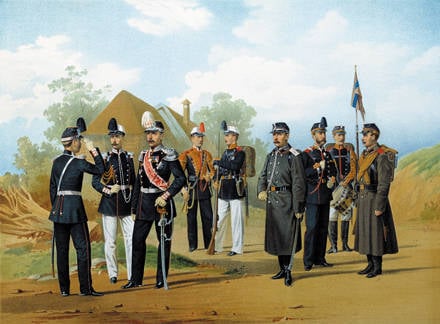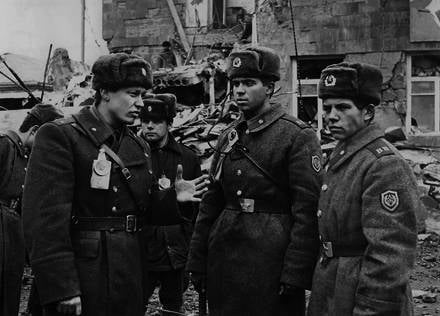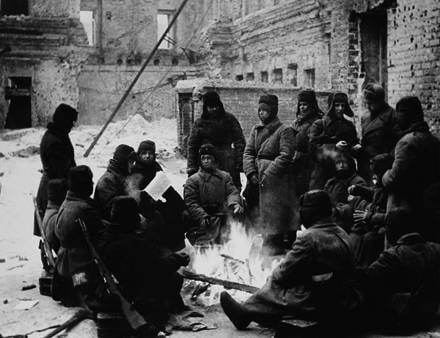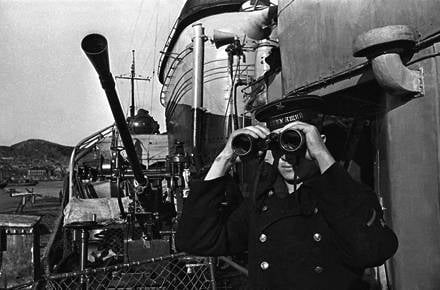Overcoat: two centuries in the army
 This type of military uniforms is familiar to every soldier, and in many civilians he is also very famous. His appearance was due to the fashion of his time, but the practical practicality and low cost of manufacturing allowed him to survive his era. The rulers left, empires disappeared, wars arose and faded, the type of military uniform changed several times, but the overcoat remained at its fighting position for a long time, and what is remarkable, practically unchanged.
This type of military uniforms is familiar to every soldier, and in many civilians he is also very famous. His appearance was due to the fashion of his time, but the practical practicality and low cost of manufacturing allowed him to survive his era. The rulers left, empires disappeared, wars arose and faded, the type of military uniform changed several times, but the overcoat remained at its fighting position for a long time, and what is remarkable, practically unchanged.Under the overcoat is usually understood uniform coat of thick woolen fabric with a fold at the back and holding it folded strap. The word itself is borrowed from French, where "chenille" means morning suit. Now there is no reliable data, who and when invented overcoat. There are only estimated dates.
The first overcoat, or rather a great coat (greatcoatb), was put on by the British at the end of the 17th century. Its appearance, of course, was different from today, primarily by the absence of sleeves. But the defensive properties, thanks to which it warmed the host well in wet and rainy weather, were quickly appreciated by the military. And at the turn of the century she comes to the army of Her Majesty. So in 1800, the Duke of Kent, the force commander in Canada, issued a decree according to which all officers in British North America were supposed to wear a double-breasted coat made of blue cloth. Two years later, in 1802, these rules were issued for the entire British army.
At about the same time, the overcoat came to Russia. At that time, our state constantly participated in wars; therefore, officials did not spare money for the army and, speaking in today's language, introduced the newest technologies. But as it happens in our country, nothing happened without incidents and sad stories.
The first mentions of the introduction of the overcoat in the army appear in the infantry charter, according to which, the overcoat was relied on to all combat and non-combat lower ranks for wearing in cold and rainy weather over the uniform. For ranks of the chasseurs battalions, and later regiments, overcoats were supposed to be built of dark green cloth, for all other regiments - of white. For each overcoat, the 4 arshin of the 4 top of the cloth and the lining of the 3 arshin of the canvas were released. Buttons, 6 pieces, were supposed to be wooden, covered with cloth. Term socks overcoat appointed in 4 year.
During 1797, part of the infantry regiments, in which the terms of the old Potemkin epancies (cloak without sleeves) were worn out and which did not have time to build new ones by the end of the year, after receiving an order to extend the term of service of epanches, they began to build overcoats in a new pattern stipulated by the charter. The overcoats, according to eyewitnesses, quickly began to gain popularity. So this is described by one grenadier of the Butyrsky regiment: “The overcoat with sleeves. It was very comfortable; unlike the cloaks; Especially in inclement weather or winter. It is possible to put on all over ammunition overcoats, but with a raincoat you can't do it: it was without sleeves. ”
 But for some reason, all these obvious advantages of overcoats were ignored by Emperor Paul, and he ordered a return to the old cloaks. Why he did it is not clear so far. Whether from considerations of cheapness of the latter, or from imitation of the Prussians, but anyway, in the new states and table sheets of field infantry and cavalry regiments, "Highest from His Imperial Majesty confirmed on 5 on January 1798 of the year" were again for all lower level officers white cloaks were introduced, with the exception of only combatant and non-combatant ranks of chasseurs regiments and non-combat musketeers and grenadiers regiments to which overcoats were left, first dark green and last white cloth.
But for some reason, all these obvious advantages of overcoats were ignored by Emperor Paul, and he ordered a return to the old cloaks. Why he did it is not clear so far. Whether from considerations of cheapness of the latter, or from imitation of the Prussians, but anyway, in the new states and table sheets of field infantry and cavalry regiments, "Highest from His Imperial Majesty confirmed on 5 on January 1798 of the year" were again for all lower level officers white cloaks were introduced, with the exception of only combatant and non-combatant ranks of chasseurs regiments and non-combat musketeers and grenadiers regiments to which overcoats were left, first dark green and last white cloth.It is not known who initiated the overcoat's return to life, but the fact remains that already at the beginning of 1799, His Imperial Highness, Grand Duke Alexander Pavlovich, who presides over the Military Department, presented to the emperor for testing new models of overcoats that were supposed to have all the ranks instead of raincoats. After the positive decision of Pavel I, Alexander Pavlovich sent these samples directly to the head of the Commissariat Expedition, General of Infantry and Cavalier Vyazmitinov, and announced the 30 of the State Military Collegium on January: white-cloth coats were laid, instead of those overcoats with overcoats, according to the highest tested new samples, assuming the proportion of the cloth was the same as that put on the cloak ; i.e .: in cavalry regiments in 5, and in other foot troops in 4 arshin 4 top for each overcoat ”.
The decree entered the Military Collegium on January 31, and already on February 5, the State Military Collegium issued a decree to the troops and all the proper authorities: “For proper execution, after the deadlines, the current amount of cloaks from the Commissariat was released to the proper number of canvas in the sleeves. "
Two years later, overcoat firmly established in the army.
There is an entry in the multi-volume “Historical description of changes in the clothes and weapons of the Russian troops ”, published in 1899, which contains all the decrees on military uniforms dating from the time of Prince Vladimir to Nicholas II, confirming the presence of an overcoat in the army of that period.
“On April 30, 1802, a new uniform, ammunition and weapons the things of the Grenadier Regiments, on the basis of which and the above four decrees, the rank-and-file of the first, or Chef’s, actually Grenadier battalions are: a uniform or caftan, trousers; boots; tie; fodder and grenadier caps, overcoat, sweatshirt; sword, with a lanyard; harness; a gun with a bayonet, a belt, a flint cover and a half-bag: cartridge bag with a bandage; satchel and aquifer. "
According to the same document, the overcoat looked like this:
“... from unpainted cloth, dark or light gray, if only in the whole regiment of the same color - with a collar and shoulder straps in color and uniform uniform, and with gray, round cuffs. It was built so that it could be worn not only on the uniform, but also on the sweatshirt or the coat. In front, it was fastened with seven copper, flat buttons, sewn from one another at such a distance that, when the belt was worn over the overcoat, the bottom button fell under the belt, and the upper half of the rear valves went beyond the belt. Modernization was constantly. From October 19 1803, "all non-commissioned officers Musketeer regiments, in uniforms and overcoats, instead of one shoulder strap, are commanded to have two."
For the rank-and-file overcoats, they were made of the cheapest cloth at the price of 65 kopecks per arshin; it was gray or, as they said, of a grain color. The overcoat fabric required a lot - one thing took about three meters, and even more than four meters on a cavalry overcoat. The fact is that the cavalry was longer, with more folds on the back. And when the rider was in the saddle, he unzipped the strap from behind and straightened the floors of his overcoat, like a blanket. The edges of the overcoat were not processed in any way - thick cloth, unlike thin cloth, is not frayed.
 Sewed overcoats of special woolen cloth, which had excellent thermal insulation properties - in field conditions, the soldiers wrapped themselves in it, like in a blanket. Modern lovers who are reconstructing historical military events have also tried: they say that it is not cold, especially if we take in front of this “front” one hundred grams. The cloth is very durable, even in fire it does not burn: for example, if a spark from a fire hit, it will not flare up, but will slowly smolder.
Sewed overcoats of special woolen cloth, which had excellent thermal insulation properties - in field conditions, the soldiers wrapped themselves in it, like in a blanket. Modern lovers who are reconstructing historical military events have also tried: they say that it is not cold, especially if we take in front of this “front” one hundred grams. The cloth is very durable, even in fire it does not burn: for example, if a spark from a fire hit, it will not flare up, but will slowly smolder.A good example of the fact that the overcoat deserved love among the soldiers is the appearance of anecdotes, fairy tales and fables with her participation. Here is one of the stories:
The master spoke with the soldier. The soldier began to praise his overcoat: "When I need to sleep, I will put on my overcoat, and put on my overcoat in my head, and cover myself with my overcoat." The master began to ask the soldier to sell his overcoat. Here they are for twenty-five rubles bargained. The master came home and said to his wife: “What kind of thing I bought! Now I don’t need any feather beds, no pillows, no blankets: I put the overcoat on my bed and put on my overcoat in my head and put on my overcoat. ” His wife began to scold him: “Well, how are you going to sleep?” And for sure, the lord laid down his overcoat, but there was nothing to put on and put on in their heads, and he was hard to lie on. The master went to the regimental commander to complain about the soldier. The commander ordered to call a soldier. They brought a soldier. “What are you, brother,” says the commander, “deceived the gentleman?” “No, no, your honor,” the soldier replies. He took the soldier's overcoat, spread it, put his head on his sleeve, and covered himself with a hollow. “How good it is,” he says, “on the overcoat after a hike I sleep!” The regimental commander praised the soldier.
On the other hand, it is believed that it was not very convenient to fight in the overcoat. Long floors got tangled under their feet and shackled movement. At one time, soldiers in the ranks were allowed to refuel the edges of their overcoats by a belt, so that it was more convenient to march.
Over the course of its “service” in the Russian, then the Soviet, and then the Russian army, the overcoat has repeatedly changed in length and style, adjusting to the needs of the military.
In the Red Army in 1919 the following style of overcoat was approved: single-breasted, in cloth of protective color, with colored valves (depending on the type of troops). Chest valves for some reason called "talk". Then the "conversations" disappeared, the overcoat began to be fastened with hooks. Since 1935, the greatcoat has become double-breasted, with a turn-down collar. On the back, there was only one oncoming fold (it used to be 6–7), apparently, to save material. The length was determined simply: measured from the floor 18-22 cm and cut off. The color of an overcoat in the army has always remained close to either protective or steel. But even if the overcoat was of the same sample, in different regions it could differ in color - dyes in different factories gave their shade. And only the naval personnel fleet always flaunted in identical black overcoats.
As in the tsarist army, the Red Army adopted the infantry and cavalry (floor-length) overcoats. They were sewn from rough gray-brown cloth. For officers and senior officers sewed overcoats of high quality cloth. The general's overcoats had lapels lined with red material, and red piping at the seams. For generals aviation such edging and lapels were blue. The front officer’s overcoat was sewn of steel cloth. In the fleet, the greatcoat was sewn from black cloth.
In Soviet times, especially in the pre-war and war years, an entire industry worked on the production of overcoats and cloth for them - millions of meters of cloth were made per year. Each overcoat took about three meters of fabric. All this, of course, came in handy during the Second World War, where the overcoats had to go along with the soldiers all the hardships and tribulations. And it was used not only by the Allied countries, but also by the Germans.
One of the best memories of what the overcoat was for people of that time can be the eponymous story of Victor Astafyev.
“... She pities her soldier's overcoat. In this overcoat, she crawled along the front lines and carried out on her the one who became the father of her only son. Under this greatcoat she slept, loved and bore her child.
Once she had nothing to feed her son, nothing to buy hot meals from the children's kitchen. It was March in the yard, and she decided that the cold was over, carried her overcoat to the market and gave it off for nothing, because at that time and on the market a lot of overcoats were being sold, almost new and with hlyastiky ... The son lay in the dark and thought about that the first gray hair of her mother probably appeared on the day she sold her overcoat. And he also thought that he had to live a very big life and it was terrible to do a lot to pay for that soldier’s overcoat without a strap. ”
 After World War II, the overcoat was still in service for a long time. A radical change came during the Afghan campaign, where she had to gradually give way to more modern clothes, say, a quilted jacket and camouflage pea coat. Although quilted jackets appeared even during the Finnish war - they were hooked to heat all under the same overcoat, only in 70-s they became independent clothing. No matter how sad, but the time of the overcoat, despite all its merits, is gone.
After World War II, the overcoat was still in service for a long time. A radical change came during the Afghan campaign, where she had to gradually give way to more modern clothes, say, a quilted jacket and camouflage pea coat. Although quilted jackets appeared even during the Finnish war - they were hooked to heat all under the same overcoat, only in 70-s they became independent clothing. No matter how sad, but the time of the overcoat, despite all its merits, is gone.In the Armed Forces of the Russian Federation overcoat as a type of uniforms disappeared. She was replaced by a double-breasted woolen coat of olive color (black for the Navy), which is worn with epaulets, chevron and emblems by the type of military. For officers and warrant officers a removable fur collar (for generals and colonels from astrakhan) and a lining is provided. Of course, they are also out of habit called the greatcoat, but there is practically nothing left from those properties that a thing with such a name should have. It is not warm and very crumpled. On the other hand, and the requirements for it have changed. If earlier it was necessary to go on the attack, now it was not required, since the coat is positioned as a kind of casual or formal dress. In addition, the uniform coat of the same tailoring began to be worn not only by the military, but also by the prosecutors, the Emergencies Ministry, Rostekhnadzor, the Russian railways and other organizations. Only the color is different.
But if the coat of the 90 sample was somehow similar in appearance and material to an overcoat, in the new version by Valentin Yudashkin it finally acquired the status of its true name - a coat with epaulets. In this form, it is used in the armies of other countries.
It is regrettable, but the overcoat gradually disappeared from army use, although it will probably be remembered for a long time to come.
Information